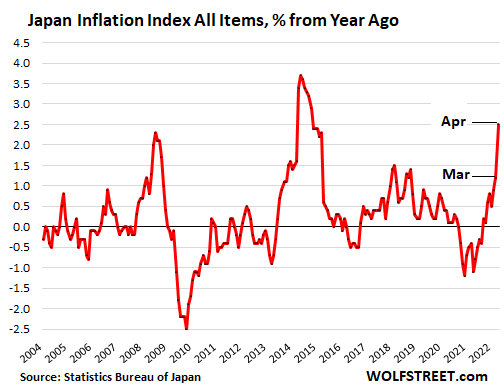Inflation Comes to Japan, amid Plunging Yen, Inflation Subsidies. Bank of Japan
The Japanese people are not amused.
By Wolf Richter for WOLF STREET:
OK, so here we go. The overall consumer price index for all items in Japan jumped by 0.4% in April from March, the third month in a row of 0.4% increases (4.8% annualized), and by 2.5% from a year ago, up from an increase of 1.2% in the prior month, Japan’s Statistics Bureau reported today.

The Japanese people are not amused.
Food prices jumped by 4.0% year-over-year, including fresh food (+12.2%), driven by the all-important categories of fresh seafood (+12.1%) and fresh vegetables (+12.2%).
“Fuel, light, and water charges” spiked by 15.7% year-over-year, including electricity (+21%), gas for the home (+17.5%), and “Other fuel and light” (+26.1%).
Prices for household durable goods, such as furnishings and appliances, jumped by 5%.
The now ended price wars amid wireless carriers still held down the overall inflation rate: The index for “communications” dropped by 10.9% year-over-year, but those price wars had peaked last year, with the steepest month-to-month drop in April 2021 (-24% from March). The year-over-year decline peaked by over 34% in December. Recent month-to-month changes indicate that rates have flattened. And going forward, this category’s downward pressure on the overall price index will dissipate, and the other price increases can carry the day.
Wholesale inflation blows out. On Monday, Japan’s wholesale price index for April was released, and it spiked by 10%, the worst jump in at least 40 years, as inflationary pressures are building up in the pipeline.
Inflation subsidies, of course. The government has passed a series of inflation relief packages, including one-time cash handouts of ¥50,000 ($391) per child to low-income families to help them pay for the higher prices.
The inflation subsidies also include cash payments made to gasoline wholesalers and distributors so that they would lower their gasoline prices, which would lower retail gasoline prices and therefore the inflation index for gasoline prices. The amount of the subsidies is adjusted weekly.
Subsidizing wholesalers is an ingenious move because it pushes down the retail price of gasoline, and thereby the inflation index, which then makes the overall consumer price index seem less bad. These subsidies to wholesalers have been in effect since early this year, and the inflation index would look worse without them.
Healthcare “inflation” largely decided by the government: pushing down on it. Health insurance and healthcare in the US are huge budget items for Americans, and inflation has been rampant. That’s not the case in Japan, which has a government health insurance system for universal coverage, funded by taxes and individual contributions. Enrollment is required, either employment-based or residence-based. The amounts that the Japanese pay directly for healthcare (co-pays, etc.) are small, compared to what Americans pay. And a lot of the consumer-facing costs are determined by the government.
So, yes, the price index for “Medical services” fell 1.8% year-over-year in April, the steepest decline in years. The index for “medicines & health…
Read More: Inflation Comes to Japan, amid Plunging Yen, Inflation Subsidies. Bank of Japan
